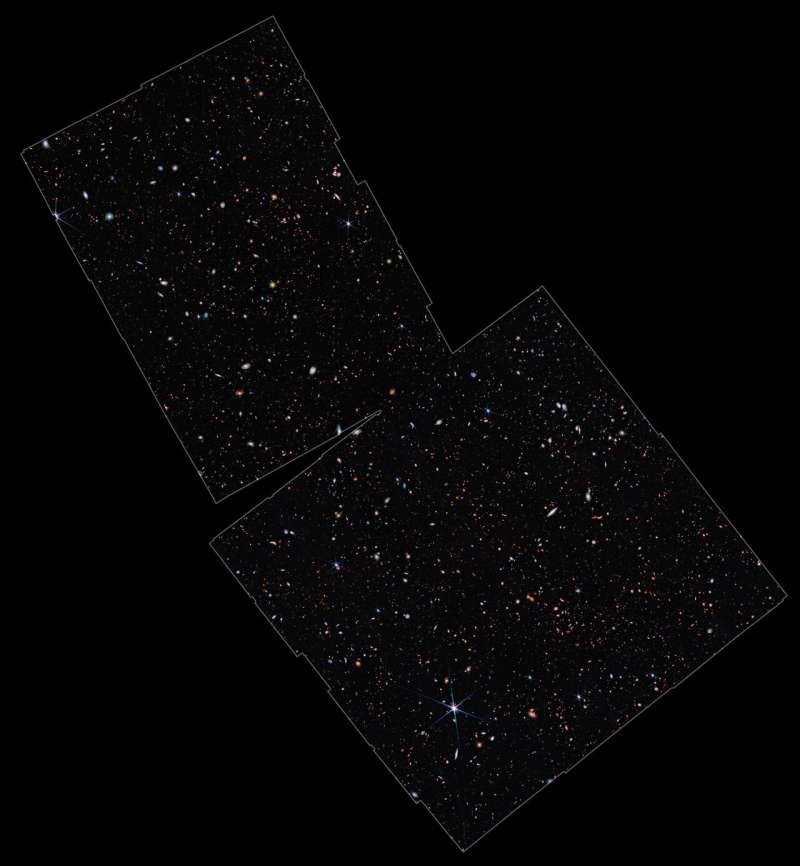The source of light that has travelled over 13.4 billion years to reach our neighbourhood in space has been determined to be the oldest, most distant galaxy ever found.
That places the most distant of these four very young objects at the very beginning of the universe, just a short while after the Big Bang—a moment when the universe was still hazy and murky and the first light was penetrating the darkness.
The JWST’s Update
The JWST’s extensive spectroscopic measurements are so thorough that scientists are able to determine some of the features of the galaxies as well as the distance these galaxies’ light has travelled.
Only 350 million years after the Big Bang, astronomer Brant Robertson of the University of California, Santa Cruz, says, “We have discovered galaxies for the first time, and we can be fully convinced of their incredible distances.”
It is a unique pleasure to discover these early galaxies in such exquisite photos.
One of the major aspirations placed in The JWST had the ability to see further back in time than we had ever seen before.
Experienced The Uncovered
Finding these early galaxies in such exquisite photos is a unique experience. One of the biggest aspirations placed in the JWST was the ability to look further back into the universe than we have ever seen.
Finding earlier and earlier items can help us learn more about this important period of development because our knowledge of the first billion years after the Big Bang is so restricted.

Recent post: Year Wrap Up: Here’re Complete Set Of Images Released By JWST So Far
The Unbelievable Composition Of Matter
We have models that explain how things happened. Before the first stars were formed, the universe, in our opinion, was composed primarily of opaque matter, which prevented any light from freely streaming since it would scatter off unbound electrons.
As these particles came together throughout time, they created neutral hydrogen; when the stars began to form, they ionized the hydrogen, and light began to shine. Within a billion years after the universe’s creation, this procedure was finished. These objects are so far away that the light they emit is incredibly weak.
Redshifting Phenomenon
The Phenomenon of Redshifting describes how the Universe has been dramatically stretched into the longer, redder end of the spectrum as a result of its expansion.
The JWST, the most potent telescope ever put into orbit, specialises in infrared and near-infrared light and was built to detect this redshifted light as accurately as possible. The light must be dissected into its component wavelengths using the spectroscopic method in order to determine a redshift with confidence.
Fine Execution Of Work By Hubble
In order to focus on four galaxies with high redshifts, two of which were first discovered by Hubble, a team of researchers divided the light from the JWST’s NIRCam into nine wavelength categories.
The two galaxies in question are among the most distant objects ever discovered, according to the most recent JWST data, and the two others are even more remote.
“It was critical to show that these galaxies do, in fact, live in the early Universe.
Mission Accomplished
Closer galaxies may appear to be very far away galaxies, which is highly conceivable “according to astronomer Emma Curtis-Lake of the University of Hertfordshire in the UK.
“The spectrum being disclosed as we had anticipated for it to be confirmed that these galaxies are indeed at the very edge of our field of vision, some much farther away than Hubble could see! The Mission has accomplished something quite exciting.”

Features Of Redshifts
Redshifts of 10.38 and 11.58 are found in the two Hubble galaxies. The latest JWST finds Feature Redshifts of 12.63 and 13.20, with the latter being comparable to roughly 13.5 billion light-years.
There are still unconfirmed candidates at higher redshifts that are being looked into. It probably won’t take long before the record is broken given that JWST hasn’t even been in service for six months yet.
A Lot More To Be Discovered
But in the interim, there is plenty to accomplish. These far-off galaxies were discovered during observations made as part of the JWST Advanced Deep Extragalactic Survey (JADES), which gathered data from an area of space near and surrounding the well-known Hubble Ultra Deep Field for a total of 28 hours.
This light reveals a wealth of information about the conditions in the early cosmos and how the first stars and galaxies formed.
Conclusion
These measurements, says Robertson, can be used to estimate the intrinsic brightness of the galaxies and their star count.
The researcher claims that it is now possible to fully analyze how galaxies have evolved over time. The researchers’ findings will be presented at STScI’s First Science Results from JWST symposium. Links to the two preprint papers can be found here and here.
